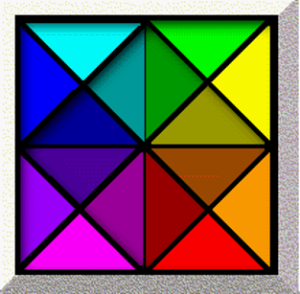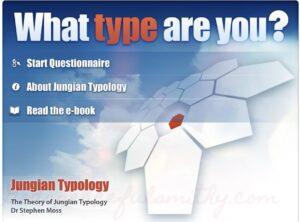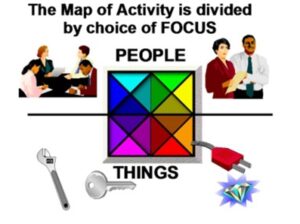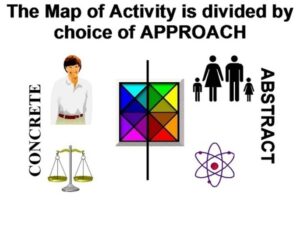
This post is about Understanding People Part 1 Many people are familiar with Personality Type theory. You many even know your “type”. However, for most people the information learned went in one ear and out the other. Here you will see some simple charts that will help you to know yourself and understand why others, think, feel, and do what they do. You will come to understand yourself and others better. This information will make you a better person, friend, spouse, salesman etc.
Walter Lowen
I want to give credit to the late Walter Lowen a math teacher from Binghamton, NY who wrote Dichotomies of the Mind. It is out of print now, was about $75 when it was in print and difficult to read. (Still available on Amazon) However, I believe Mr. Lowen took personality type theory a quantum leap more insightful. It has been my hope to make his complex ideas easy to understand
Simple Choices
First understand that it’s all about the simple choices we make in our lives. Choices over which we may or may not have complete control: like being left handed or right handed. Also understand that although we have a dominant choice, we can still choose the other. So we are all more or less left handed or right handed. Some of us are even ambi-dextrous (both right) or “ambi-sinister” (both left). That last is my idea, because that’s me: ambi-sinister. Not evil just both left rather than both right!

The Map of Activity

Now familiarize yourself with the graphic of this step. All the graphics that follow will be related to this square divided into 16 colored triangles. I call it the Map of Activity. We will examine this map and its many territories. It will be divided top to bottom and side to side you will come to understand each of the little triangles as though they were separate states in a map of the United States. Moreover, as we get into the subject of conscious versus unconscious, you will understand how different parts of us may sit on different parts of the map. All that will come in time and this post we will begin by dividing them up top and bottom side to side.
In Myers-Briggs personality type theory there are 16 distinctly different types. You can take various tests available online that can help you understand what type you are on the other hand, you might be able to guess as you come to understand the theory as presented in these posts. You might make some notes of your own describing. What do you think your preferences are for each section of the map. Then before or after compare the results with whatever online test, you decide to try. I like to use the following App in the Apple APP store,

FOCUS
The first simple choice we have in life has to do with what captures our attention. Again remember we can do both, but choose one more than the other. Lowen called this choice a Dichotomy and he labeled it Focus
FOCUS. Focus divides the Map of Activity from top to bottom. Given the choices, as we are all the time, do you prefer to FOCUS on PEOPLE or THINGS? It is important to remember that this is a matter of preference, and not of exclusion. Certainly we all think about people and we all think about things. Dr. Jordan Peterson often points out that women tend to be more interested in people and men tend to be more interested in things. The episodes here should be on tends to. For example, I really prefer people and I am definitely a man.
APPROACH
The next step we all take in life is to decide how we APPROACH the people or things that make up our FOCUS. Do we choose to approach CONCRETE real people or things? Would we prefer to approach things and people in the ABSTRACT. For example, am I more interested in family relationships and dynamics or my brother, Nick. Do I like to study engineering or work on my car? The simple choice of APPROACH divides the Map of Activity from side to side. From my own experience, I think these choices might come on a continuum. I certainly am interested in my relationships with individual people: my wife, my friends, my parishioners on the other hand I am really excited about the intellectual pursuit of understanding personality theory.
FUNCTIONS
Now we see where Lowen’s theory connects to more mainstream personality type theory of Carl Jung and Briggs-Myers. It is the combination of FOCUS AND APPROACH that leads to the choices of the four FUNCTIONS of FEELING, INTUITION, SENSING, and THINKING.
Also, let me repeat something I explain in the introduction post to the subject. That is that Lowen continually builds a pair of opposites upon another pair of opposites upon another upon another.
 Click < to go to part 2
Click < to go to part 2
- FEELING chooses CONCRETE PEOPLE
- INTUITION chooses ABSTRACET PEOPLE
- SENSING chooses CONCRETE THINGS
- THINKING chooses ABSTRACT THINGS.
In more familiar MBTI language as an ENFJ I am indeed interest both in abstract and specific (concrete) people. Sensing Thinking types on the other hand being interest in concrete things make good athletes.
Let’s recap.
Here we have seen the dichotomy Lowen calls FOCUS. When looking at the world, wherewe focus our attention the choice is either PEOPLE or THINGS.
When we APPROACH what we FOCUS upon we are interested either in CONCRETE PEOPLE and THINGS or ABSTRACT ones.
When these new dichotomies are combine the result is the four FUNCTIONS of Type Theory: SENSING, THINKING, FEELING, and INTUITION.
Let these ideas sink in and then move on to the next How to understand people articles. Part 2 is The Four Functions. In it you will learn the preferences that set the functions apart and help them work together. You will come to understand yourself in part by the words and phrases that reveal your simple choices.


